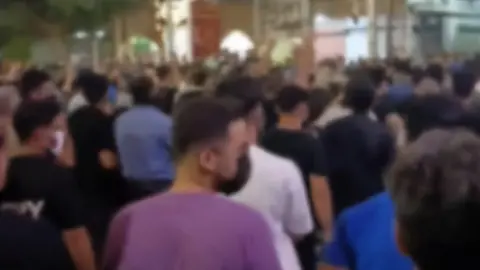Iran protests: Fresh clashes in Zahedan
 Twitter
TwitterIntense clashes have taken place in the Iranian city of Zahedan, as anti-government unrest grips the country.
Social media footage showed security forces firing into crowds, four weeks after dozens were killed in protests there over allegations a teenage girl was raped by a senior policeman.
State media said one person was killed and 14 injured in Friday's violence.
Iran has also been rocked by wider protests sparked by the death of a young Kurdish woman in police custody.
The unrest is the most serious challenge to the Islamic Republic.
On Friday, crowds in Zahedan, capital of the Sistan Baluchistan province, took to the streets despite the announcement that two senior police officials had been sacked over the deadly 30 September clampdown.
Video sent to the BBC Persian Service shows floors of buildings washed with blood, as protesters shout "Death to Khamenei" - a reference to Iran's Supreme Leader Ayatollah Ali Khamenei.
One video shows one of the latest casualties, apparently a child.
"They fired at a 12-year-old," one man shouts as another strokes the cheek of the boy shot dead.
It is not clear how many people died on 30 September - some reports by human rights organisations have put the number at more than 90.
It is rare for Iranian authorities to sack senior officials involved in suppressing protest against the country's top leadership - but even that measure appears to have failed to stem the unrest.
Sistan Baluchistan province, which borders both Pakistan and Afghanistan, has a sizeable Sunni Muslim population. Iran is a majority Shia country.
Authorities have said the security forces were attacked by armed Baluchi separatists - something the imam of the city's biggest mosque has denied.
The protests in Zahedan come as Iran has been gripped by the reaction to the death of Mahsa Amini, 22, on 16 September.
She had been detained three days earlier by the morality police in Tehran and fell into a coma after collapsing at a detention centre.
She was arrested for allegedly wearing her Islamic headscarf "improperly".
There were reports that officers had beaten her with a baton and banged her head against a vehicle, but police denied she had been mistreated and said she had suffered a heart attack.
Norway-based Iran Human Rights says at least 234 protesters, including 29 children, have been killed by security forces in crackdowns around Iran so far. Iran's leaders have portrayed the unrest as "riots" instigated by foreigners.
The BBC and other independent media are banned from reporting from inside Iran, making state media and other reports hard to verify. Authorities have also heavily disrupted the internet, hampering the ability of protesters to post on social media.

Wave strengthens

The Islamic Republic of Iran has seen protests before. But not like this.
One month ago, dozens of people were killed in Zahedan.
It was the bloodiest day yet in what have been six weeks of protest. But that hasn't deterred demonstrators in this city or in all of Iran's 31 provinces.
In addition to those killed across Iran, more than 13,000 have been detained so far. The UN has expressed concern that the authorities are now refusing to release some of the bodies of those who have died - they know every new death provokes yet another outpouring of anger and grief.
The authorities are still trying to dismiss and discredit them as "rioters influenced by foreigners".
It's hard to square that with extraordinary images of teenage schoolgirls rejecting obligatory headscarves, of women of all ages walking bare-headed in public spaces.
It's hard, too, to see Iran returning to days where so-called morality police can police women's dress the way they've done for decades.
This is now about more, much more, than what women wear.
In the past, major uprisings have fizzled out, or were forcibly suppressed, after months of unrest. But, with every week, this wave seems to strengthen.
The full force of Iran's security apparatus has yet to be unleashed. The authorities will do whatever it takes to preserve the Islamic Republic.
But Iran's protesters, especially a new generation of women and men, also seem ready to do whatever it takes to change their lives, and much more.

